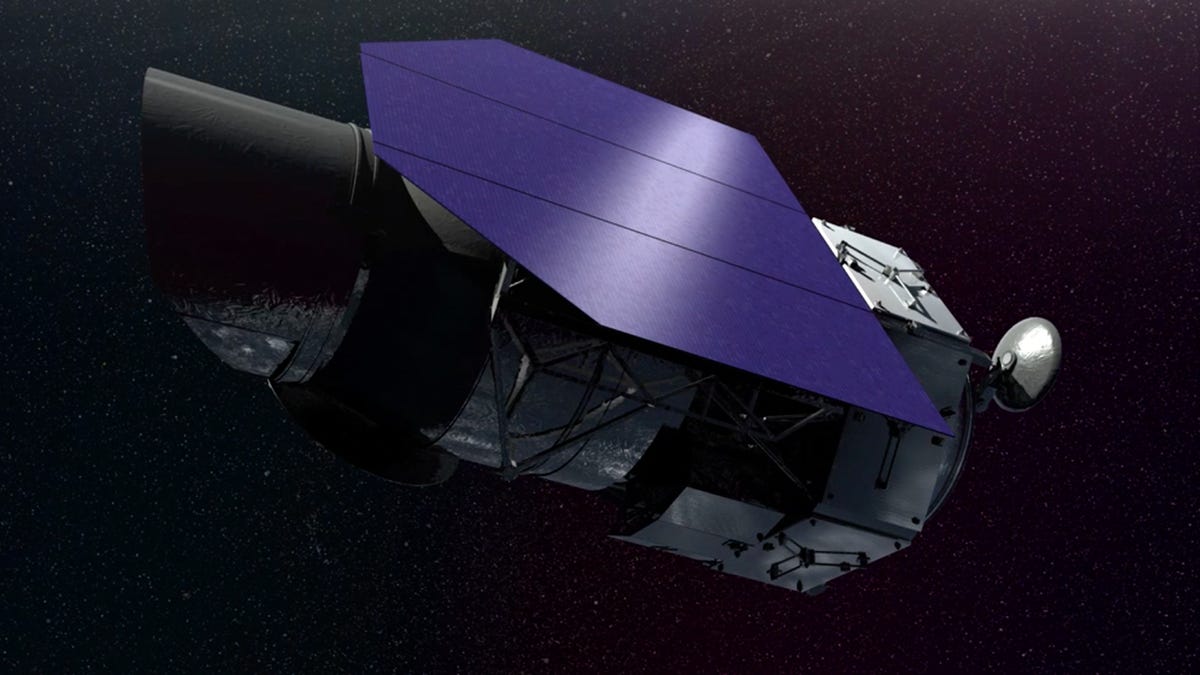Trump budget has no room for the telescope that could find distant alien life
The White House wants to cancel Wfirst, an observatory scientists say should be NASA's top large space mission.

Artist's Rendering of Wide-Field Infrared Survey Telescope (WFIRST)
For the second time in the past two years, the Trump administration has proposed canceling a planned space telescope that could help us search for life on distant exoplanets, unlock the mysteries of dark energy and explain the universe's other persistent puzzles.
The White House released its proposed budget for the next fiscal year this week that cuts funding for a number of science programs across departments. While NASA fared relatively well, the budget still seeks to completely zero out the space agency's Wide-Field Infrared Survey Telescope (Wfirst), which would follow the oft-delayed James Webb Space Telescope.
"The Budget proposes to terminate the Wfirst mission. Given delays and cost growth with the James Webb Space Telescope (JWST), the Administration is not ready to proceed with another multi-billion-dollar space telescope," reads one of the proposed budget documents.
The JWST is set to become the more powerful successor to the Hubble Space Telescope, but the project has run into problems, cost overruns and delays. It's now targeting launch in 2021.
Wfirst, on the other hand, has always been meant to launch after JWST with different science goals.
"Wfirst and JWST are highly complementary," said Princeton University astronomy professor David Spergel, who is a co-chair on the WFIRST science team. "JWST stares deeply at small regions of the sky and will give us detailed information about individual objects while Wfirst will map large regions of the sky."
Looking deeper into the universe also means looking back further in time, to study some of the very first stars and galaxies.
Wfirst is smaller than JWST but has a wide field of view and can see in both infrared and visible light. This broader vantage point on deep space makes it better for looking at the universe on a large scale and therefore better for studying elusive and invisible but likely abundant aspects of existence, like dark matter and dark energy.
To put it another way, imagine you want to learn not about the universe, but something a little more comprehensible, like the ecosystem along the shore of a beautiful high mountain lake. JWST is kind of like the microscope you might use to look at samples of the ecosystem close-up, whereas Wfirst is more like a photographer's wide-angle lens with a bunch of fancy filters that can provide a better view of the whole scene, allowing you to survey the broader habitat for wildlife.
"They are two very different telescopes with very different missions," astronomer, former Sky and Telescope editor and current American Astronomical Society (AAS) Press Officer Rick Fienberg told me. "Wfirst ... is designed to address questions we are asking now and that can't be addressed, with few exceptions, by JWST."
The planned wide-field telescope will also come equipped with an advanced coronagraph, which will allow for some of the first and most detailed images of planets beyond our solar system. Right now, telescopes like NASA's Transiting Exoplanet Survey Satellite (TESS) spot distant planets primarily by looking for blips in the light from their host stars as they pass in front of them. But Wfirst's coronagraph will offer a major leap forward that should allow us to get a closer look at individual exoplanets, their atmospheres and even potential biosignatures that could be an indication that life is present.
"It's also reasonable to note that not only will Wfirst help us answer very compelling science questions that are different from what we can answer with JWST, the risk and cost of Wfirst are considerably lower," added AAS President Megan Donahue. "NASA could start building Wfirst tomorrow, for less money than the same mission would cost 5-10 years from now. There is no scientific or engineering reason for Wfirst to be delayed."
Wfirst was also the highest priority mission in NASA's most recent decadal survey. Every ten years, the agency surveys the science community to determine which projects are most important and Wfirst basically won the gold medal in 2010.
Work has already started in earnest on Wfirst with the re-polishing of the mirrors and testing of the telescope's detectors, according to Spergel. The National Reconnaissance Office, which develops spy satellites for the US Department of Defense, donated two surplus mirrors to NASA and one was designated for Wfirst.
"If NASA stops building WFIRST in the middle of its construction, it will be highly wasteful and will abandon our leadership in these areas of astrophysics," he told me.
A previous Trump administration budget also proposed canceling Wfirst a year ago.
But in 2018, Congress ultimately restored funding for Wfirst in the final budget that NASA is currently operating under, and which the President just recently signed into law. So, for now, the future of Wfirst remains in legislative limbo until Capitol Hill and the White House hash out a final budget.
"The cancellation of Wfirst would set a dangerous precedent and severely weaken a decadal-survey process that has established collective scientific priorities for a world-leading program for a half century," AAS executive officer Kevin Marvel said at the time in a release. "We cannot allow such drastic damage to the field of astronomy, the impacts of which would be felt for more than a generation."

